Scientists Stumble Upon Baby Horse Frozen In Time For 40,000 Years
Finding the remains of animals that have been dead for tens of thousands of years isn't easy. If you're lucky, you'll find a handful of bones, or maybe even a near-complete skeleton, but that's about the best most scientists can hope for. So, when researchers in Siberia stumbled upon the body of a 40,000-year-old baby horse so perfectly preserved that it still has its hair, you can see why it would be cause for celebration.
The foal, which is thought to have been a member of an ancient population of wild horses which inhabited the Russian republic of Yakutia between 30,000 and 40,000 years ago, is pristine. With zero damage to its body, the young horse remained frozen in the ground, just waiting for researchers to find it.
Discoveries such as this are important for a number of reasons. Not only does it reveal exactly what these ancient animals looked like, but it also allows scientists to study the way they lived in incredible ways. For example, the horse's internal organs can now be searched for evidence of its last meal, telling us about its diet as well as what kind of plants were present in the area at the time of its death tens of thousands of years ago.
Scientists believe the tiny horse was only around two months old when it died. It's unclear how it died, but the lack of damage to its body would suggest that it didn't fall victim to a predator. A full autopsy is planned for the near future, but in the meantime the researchers have taken samples of from the body and the earth that encased the remains.
Wild horses — that is, horses with no ancestors who had been domesticated — are thought to be extinct on Earth today. Przewalski's horse, once thought to be the last remaining wild horses still alive today, were recently revealed to be the descendants of a population of domesticated horses. If true, that would make the population feral rather than wild, and would also mean there's no truly wild horses left.
